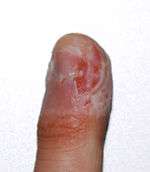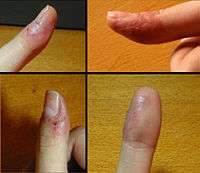Dermatophagia
| Dermatophagia | |
|---|---|
 | |
| Extreme nail biting / biting of skin to point of an obsessive compulsive disorder (OCD) or other condition leading to self mutilating behaviour such as autistic spectrum disorders (as is the case in this example) or Lesch-Nyhan Syndrome. |


Dermatophagia (from Ancient Greek δέρμα - skin - and φαγεία - eating) is a compulsion disorder of gnawing, biting or eating one's own skin, most commonly at the fingers. People with dermatophagia typically bite the skin around the nails, leading to bleeding and discoloration over time. Some people also bite on their skin on their finger knuckles which can lead to pain and bleeding just by moving their fingers. Some usually consume the flesh during an episode. Contemporary research suggests a link between impulse control disorders and obsessive–compulsive disorders,[1] and this may be addressed in the DSM-5, published in May 2013.[2][3] Further information on OCD, other anxiety disorders, and dermatophagia and other impulse-control disorders can be found in the DSM-IV TR.[4]
Behavior
People with dermatophagia chew their skin out of compulsion, and can do so on a variety of places on their body.[5] Those with dermatophagia typically chew the skin surrounding their fingernails and joints. They also chew on the inside of their mouth, cheeks, and/or lips, causing blisters in and outside of the mouth. If the behavior is left unchecked for an extended period, calluses may start to develop where most of the biting is done.
Skin chewing can be bolstered by times of apprehension and other unpleasant events.[5] Blisters in particular can cause a feeling of desire to pull or bite off the affected skin and nails (since the skin is dead, thus easily pulled off), which could be detrimental, causing infection. Another disorder, known as dermatillomania, the act of picking at one's skin, can sometimes accompany dermatophagia. People who have dermatophagia can also be prone to infection as when they bite their fingers so frequently, they make themselves vulnerable to bacteria seeping in and causing infection. Dermatophagia can be considered a "sister" disorder to trichophagia, which involves compulsively biting and eating one's hair.[6]
Management
There is not yet a known way to remedy this tendency. Small things can be done to delay the urge a bit, such as chewing gum, and chewing on a soft drink straw.
See also
Notes
- ↑ Grant; et al. (January 2010). "Impulse-control disorders in children and adolescents with obsessive-compulsive disorder". Psychiatry Res. 175: 109–13. doi:10.1016/j.psychres.2009.04.006. PMC 2815218. PMID 20004481.
- ↑ "Nail-Biting May Be Classified As OCD In New DSM". The Huffington Post. 1 November 2012. Retrieved 8 February 2013.
- ↑ American Psychiatric Association. "DSM-5: The Future of Psychiatric Diagnosis". Retrieved 8 February 2013.
- ↑ American Psychiatric Association (2000). Diagnostic and statistical manual of mental disorders (4th. ed., text revision). Washington, DC.
- 1 2 Al Hawsawi, K.; Al Aboud, K.; Ramesh, V. (2003). "Dermatophagia Simulating Callosities" (pdf). Dermatology Psychosomatics. 4: 42–43. doi:10.1159/000070535.
- ↑ "Dermatophagia". fingerfreak. FingerFreak.com. Retrieved April 27, 2009.